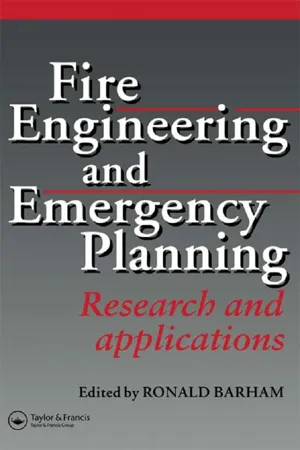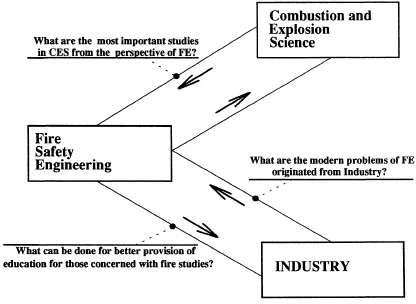
This is a test
- 576 pages
- English
- ePUB (mobile friendly)
- Available on iOS & Android
eBook - ePub
Book details
Book preview
Table of contents
Citations
About This Book
Protection against fire and prevention of explosion is vital in a modern industrial economy. This published proceedings of the First European Conference on Fire Engineering and Emergency Planning provides an authoritative base of materials covering the latest research, applications and hypotheses as a cumulative reference work and a platform for exchanges of ideas within the academic fire community.
Frequently asked questions
At the moment all of our mobile-responsive ePub books are available to download via the app. Most of our PDFs are also available to download and we're working on making the final remaining ones downloadable now. Learn more here.
Both plans give you full access to the library and all of Perlego’s features. The only differences are the price and subscription period: With the annual plan you’ll save around 30% compared to 12 months on the monthly plan.
We are an online textbook subscription service, where you can get access to an entire online library for less than the price of a single book per month. With over 1 million books across 1000+ topics, we’ve got you covered! Learn more here.
Look out for the read-aloud symbol on your next book to see if you can listen to it. The read-aloud tool reads text aloud for you, highlighting the text as it is being read. You can pause it, speed it up and slow it down. Learn more here.
Yes, you can access Fire Engineering and Emergency Planning by R. Barham in PDF and/or ePUB format, as well as other popular books in Architecture & Architecture General. We have over one million books available in our catalogue for you to explore.
Information
PART ONE
FUNDAMENTAL ISSUES
1 INTRODUCTION
The organisers have asked me to set the conference off by giving you an overview of what you might expect and saying something about why you are here.
The fire research and fire fighting community is about the same as in other techniques like chemicals. You have two main groups: at one extreme are the senior academics - who know it all and do very fine scientific research; at the other extreme, the fire-fighters - who put the fires out and are supposed to have knowledge of what these researchers have done, but unfortunately do not speak to them. In between these two extremes you have the young, upcoming academics - who might have access to the senior academics (if the senior academics have time) but are unlikely to see more of a fire than the fire drill in the laboratory.
Nevertheless, it should be noted that fires become more complex. Not necessarily by scale, because we used to have whole cities burn to the ground. In terms of fire technology that is relatively easy to deal with because they were mainly wood fires - but now fires are more complex: we now have fires in chemical industries; we have vapour cloud explosions; and we frequently have to deal with complicated chemical reactions. For example, you might have a fire on your hands in a nuclear power station but, equally, a 747 might crash into an apartment building (as happened in the Netherlands three years ago) and you might find yourself in the situation that we were - where you need all the equipment that you can possibly lay your hands on and you need all the knowledge that you possibly can lay your hands on - and within about half an hour, CNN has broadcast it all over the world. Members of the families of those potentially involved in the accident started to phone in from all over the world. This caused a breakdown of the telephone system and, eventually, the radio communication system. At this point, they started to use overseas short wave communication of their own, thus wrecking the radio system as well and so, as you can see, things can get nasty.
Also, in such situations, your emergency planning and your evacuation planning is subjected to severe complications. First of all people might no longer believe what you tell them to do; and, secondly, you might end up with enormous traffic jams. In the Boeing 747 disaster, we needed traffic policemen to actually direct the traffic of the ambulances and the fire trucks, themselves. We also needed police assistance in keeping out bystanders who wanted to make video tapes of the disaster for the home video. With all this complexity, it is necessary to understand not just the behaviour of complex fires but also to understand the behaviour of a complex built environment and to understand the behaviour of people within it.
These are the matters that we are going to discuss during this conference. The first day will mainly be devoted to fundamental research, the second day will then slide towards applications in concrete situations and emergency planning, and the last day will mainly be spent looking at education, operations and emergency preparedness.
Other people will set the pace for the next days; I will shortly give you the pace for today. First, we will cover flame behaviour, fire behaviour, combustion processes, and flashover - looking at how a small fire can become a big one in a very short time; and then the behaviour of all sorts of new building materials that might create new problems. In the second session, we then look at applications of those series into actual buildings. We look at situations such as where you might have critical or vulnerable or very expensive equipment (such as computer equipment) in a building which you need to protect but still you want to take the fire out and, then, in the third session we look at emergency planning and crowd control, the logistics of how to be there on time and how to organise your preparedness plan.
These various matters should nicely fill the day - starting off with theory and ending with practice. However, this day should not only be a listening day. As I said at the beginning, one of the drawbacks of having a well-developed and very interesting science is that the practical applications get lost because the academics get bogged down in solving differential equations while others are trying to build more fire trucks. So if you have time, and I hope you will take the time, speak to each other. Figure out what the academics can mean to you. And to the academics, I say don't think that you know it all - because these fire-fighters have taken the heat of the actual fire and know, in all probability, what they are facing in a live fire situation.
With that I wish you a very nice day.
SECTION ONE
FIRE ENGINEERING
2 RESEARCH IN FIRE ENGINEERING: COMBUSTION AND EXPLOSION SCIENCE AND INDUSTRIAL PROBLEMS
Abstract
The state of the art in fire engineering is crucially dependant on achievements in combustion and explosion science and problems originating from within industry. In this connection the following two basic issues are considered: modern trends in combustion and explosion science and modern industrial problems which are important for fire engineering. Examples of recent studies are given.
Keywords: Fire engineering, research, combustion, explosion, industry.
1 Introduction
To begin a discussion on research in fire engineering the mutual links between Fire Engineering, Combustion and Explosion Science and Industry (see Fig. 1) should be considered.
Fire Engineering (FE) is essentially based on Combustion and Explosion Science (CES) which has been providing the necessary background, solutions of principle, new qualitative information, methods and techniques. Also, it puts forward new concepts for FE and revises former approaches.
From this perspective, it is important to follow the modern trends in CES that seem promising for FE and could be incorporated into FE research in the near future. This is the first main question arising when evaluating the research in FE along with the link CES------> FE (see sketch in Fig. 1):
- What are the most important modern studies in CES from the perspective of FE?

Fig. 1. Mutual links
In turn, FE tends to adopt, use and apply those issues originated with CES. Eventually, this stimulates new engineering solutions, implementation and improvement of codes, regulations and standards, development of proper preventive anti fire and anti-explosion measures, provision of required fire design, implementation of adequate testing facilities and equipment, and further development of legislation. All this allows FE to meet the needs of modern industry in fire protection including building, petro-chemical industry, transportation, and energetics. Obviously, a high enough level of education must be achieved. That is why, along with the link FE ------> Industry the second important question arises :
- What can be done for better provision of education for those concerned with fire studies?
This question will be discussed in a different session of the conference and is not pursued here.
From another perspective, FE is under permanent pressure from industry which poses new technical problems and requirements. Along with the link Industry ------> FE the third question arises that needs to be answered :
- What are the modern problems of FE originating from Industry?
This cycle of reciprocal links is closed: in its turn, FE with its efforts to resolve the problems originated with industry has an influence on CES, demanding new methods, methodologies and approaches to be incorporated in research in fire and explosion studies.
Hopefully, the questions posed above will be a catalyst for further discussion. Proper answers to these questions and related discussions would give a chance to describe the state-of-the-art of research in FE. Havi...
Table of contents
- Front Cover
- Half Title
- Title Page
- Copyright
- Contents
- Introductions
- List of contributors
- Preface
- EuroFire ‘95 Introductory Remarks
- PART ONE: FUNDAMENTAL ISSUES
- PART TWO APPLICATIONS
- PART THREE EDUCATIONAL AND OPERATIONAL CONSIDERATIONS
- Report of the Plenary Session
- APPENDICES
- Index